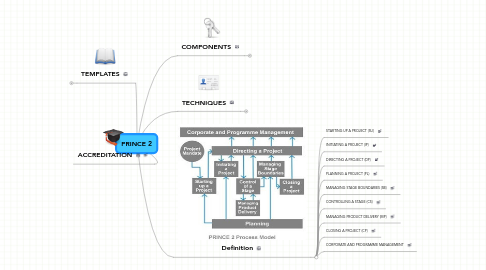
1. ACCREDITATION
2. TEMPLATES
2.1. AUTHORISATIONS
2.1.1. Initiation
2.1.2. Start-up
2.1.3. Exception Plan
2.1.4. Closure
2.1.5. Continuation
2.2. PROJECT
2.2.1. Project Mandate
2.2.2. Project Brief
2.2.2.1. Project Brief
2.2.2.2. Business Case
2.2.2.3. Project Issues
2.2.2.4. Configuration Management Plan
2.2.2.4.1. Configuraton Item Record
2.2.2.5. Project Plan
2.2.2.6. Project Organsation
2.2.2.7. Acceptance Criteria
2.2.2.8. Cost Benefit Analysis
2.2.2.9. Communications Plan
2.2.3. Project Initiation Document (PID)
2.2.4. Project Approach
2.2.5. Project Risk Assessment
2.2.6. Project Quality Plan
2.2.7. Project Fies
2.2.8. Post Project Review Plan
2.2.9. End Project Report
2.2.10. End Project Notification
2.3. STAGE
2.3.1. Stage Plan
2.3.2. Daily Log
2.3.3. Exception Report
2.3.4. Project Stage Log
2.3.5. Checkpoint Report
2.3.6. End Stage Report
2.3.7. End Stage Notification
2.4. PRODUCT
2.4.1. Product Description
2.4.2. Product Status Checklist
2.4.3. Product Cecklist
2.5. RISK AND ISSUES
2.5.1. Risk Log
2.5.2. Issue Log
2.5.3. Risk and Issues Template
2.6. QUALITY
2.6.1. Quality Plan
2.6.2. Quality Log
2.6.3. Quality Review Error List
2.6.4. Quality Review Follow-up Action List
2.6.5. Quality Review Invitation
2.6.6. Quality Review Sign-off
2.7. LESSONS LEARNED
2.7.1. Lessons Learned Report
2.7.2. Lessons Learned Log
2.8. REPORTS
2.8.1. Project Highlight Report
2.8.2. Customer Acceptance
2.8.3. Programme Highlight Report
2.8.4. Highlight Report
2.9. WORK PACKAGE
2.9.1. Work Package Authorisation
2.9.2. Work Package Description
